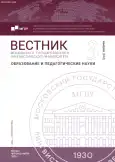Network-Based Approach to the Structure of Semantic Memory of Foreign Language Learners: Specific and Possibilities of their Use
- Autores: Barmin A.V.1, Velichkovsky B.B.1
-
Afiliações:
- Moscow State Linguistic University
- Edição: Nº 3 (848) (2023)
- Páginas: 99-105
- Seção: Psychological studies
- URL: https://journal-vniispk.ru/2500-3488/article/view/347352
- ID: 347352
Citar
Texto integral
Resumo
The article is aimed at considering the issues of applying the network-based approach to the structure of the semantic memory of foreign language learners. The literature review made it possible to determine the specifics and possibilities of applying the network-based approach to the structure of the semantic memory of foreign language learners.
Palavras-chave
Sobre autores
Artem Barmin
Moscow State Linguistic University
Autor responsável pela correspondência
Email: art.barmin@mail.ru
Post-Graduate Student of the Department of Psychology and Pedagogical Anthropology of the Institute of Humanities and Applied Sciences of Moscow State Linguistic University
RússiaBoris Velichkovsky
Moscow State Linguistic University
Email: velitchk@mail.ru
Doctor of Psychology, Professor of Moscow State University, Head of the Laboratory for Cognitive Studies of Communication, Moscow State Linguistic University
RússiaBibliografia
- Runge A., Hovy E. Exploring neural entity representations for semantic information // arXiv preprint arXiv: 2011.08951. 2020. P. 1–13. https://doi.org/10.48550/arXiv.2011.08951
- Hasnine M. N. et al. A platform for image recommendation in foreign word learning / M. N. Hasnine, M. Ishikawa, V. Flanagan, H. Ogata // Society for learning analytics research (SoLAR): Conference: 9th International Learning Analytics and Knowledge (LAK) ConferenceAt: Arizona, USA. 2019. P. 187–188.
- Дубинина Г. А., Каменская Н. В. Поиск новых форм контроля и оценки качества подготовки по иностранному языку в неязыковом вузе // Вестник Московского государственного лингвистического университета. Образование и педагогические науки. 2018. Вып. 2 (796). С. 202–211.
- De Brigard F., Umanath S., Irish M. Rethinking the distinction between episodic and semantic memory: Insights from the past, present, and future // Memory & Cognition. 2022. Vol. 50. № 3. P. 459–463.
- Лурия А. Р. Язык и сознание. М.: Изд-во МГУ, 1979.
- Smith E. E., Shoben E. J., Rips, L. J. Structure and process in semantic memory: A featural model for semantic decisions // Psychological Review. 1974. Vol. 81. № 3. P. 214–241.
- Recchia G. et al. Encoding sequential information in vector space models of semantics: Comparing holographic reduced representation and random permutation / G. Recchia, M. Jones, M. Sahlgren, P. Kanerva // Proceedings of the Annual Meeting of the Cognitive Science Society. 2010. Vol. 32. № 32. P. 1–7.
- Kumar A. A. Semantic memory: A review of methods, models, and current challenges // Psychonomic Bulletin & Review. 2021. Vol. 28. P. 40–80.
- Collins A. M., Loftus E. F. A spreading-activation theory of semantic processing // Psychological Review. 1975. Vol. 82. № 6. P. 407–428.
- Siew C. S. Q. et al. Cognitive Network Science: A Review of Research on Cognition through the Lens of Network Representations, Processes, and Dynamics / C. S. Siew, D. U. Wulff, N. M. Beckage, Y. N. Kenett // Complexity. 2019. Vol. 2019. P. 1–24.
- Kumar A. A., Steyvers M., Balota D. A. A critical review of network-based and distributional approaches to semantic memory structure and processes // Topics in Cognitive Science. 2022. Vol. 14. № 1. P. 54–77.
- De Deyne S. et al. Structure at every scale: A semantic network account of the similarities between unrelated concepts / S. De Deyne, D. J. Navarro, A. Perfors, G. Storms // Journal of Experimental Psychology: General. 2016. Vol. 145. № 9. P. 1228–1254.
- Kumar A. A., Steyvers M., Balota D. A. Semantic memory search and retrieval in a novel cooperative word game: A comparison of associative and distributional semantic models // Cognitive Science. 2021. Vol. 45, № 10. P. 1–33.
- Steyvers M., Tenenbaum J. B. The large-scale structure of semantic networks: Statistical analyses and a model of semantic growth // Cognitive science. 2005. Vol. 29. № 1. P. 41–78.
- Morais A. S., Olsson H., Schooler L. J. Mapping the structure of semantic memory // Cognitive science. 2013. Vol. 37. № 1. P. 125–145.
- McNamara T. P. Semantic Priming: Perspectives from Memory and Word Recognition. New York: Taylor & Francis, Psychology Press, 2005.
- Denervaud S. et al. Education shapes the structure of semantic memory and impacts creative thinking // npj Science of Learning. 2021. Vol. 6. № 1. P. 1–7.
- Fernandez-Fontecha A., Kenett Y. N. Examining the relations between semantic memory structure and creativity in second language // Thinking Skills and Creativity. 2022. Vol. 45. P. 1–39.
- Agustin-Llach M. P. How age and L2 proficiency affectthe L2 lexicon // System. 2022. Vol. 104. P. 1–12.
- Coltheart M. Are there lexicons? // The Quarterly Journal of Experimental Psychology Section A. 2004. Vol. 57. № 7. P. 1153–1171.
- Овчинникова И. Г. О влиянии частотности коллокации лексем на взаимосвязи единиц ментального лексикона // Вестник Пермского университета. Российская и зарубежная филология. 2010. Вып. 1 (7). С. 26–30.
- Nelson D. L., McEvoy C. L., Schreiber T. A. The University of South Florida free association, rhyme, and word fragment norms // Behavior Research Methods, Instruments, & Computers. 2004. Vol. 36, №. 3. P. 402–407.
- Zemla J. C., Austerweil J. L. Estimating semantic networks of groups and individuals from fluency data. Computational Brain & Behavior. 2018. Vol. 1. № 1. P. 36–58.
- Coltheart M. The MRC psycholinguistic database // The Quarterly Journal of Experimental Psychology Section A. 1981. Vol. 33. № 4. P. 497–505.
- Wulff D. U. et al. Using network science to understand the aging lexicon: Linking individuals' experience, semantic networks, and cognitive performance // Topics in Cognitive Science. 2022. Vol. 14. № 1. P. 93–110.
- Barabasi A. L., Albert R. Emergence of scaling in random networks // Science. 1999. Vol. 286. № 5439. P. 509–512.
- Hills T. T. et al. Longitudinal analysis of early semantic networks: Preferential attachment or preferential acquisition? // Psychological science. 2009. Vol. 20. № 6. P. 729–739.
Arquivos suplementares









